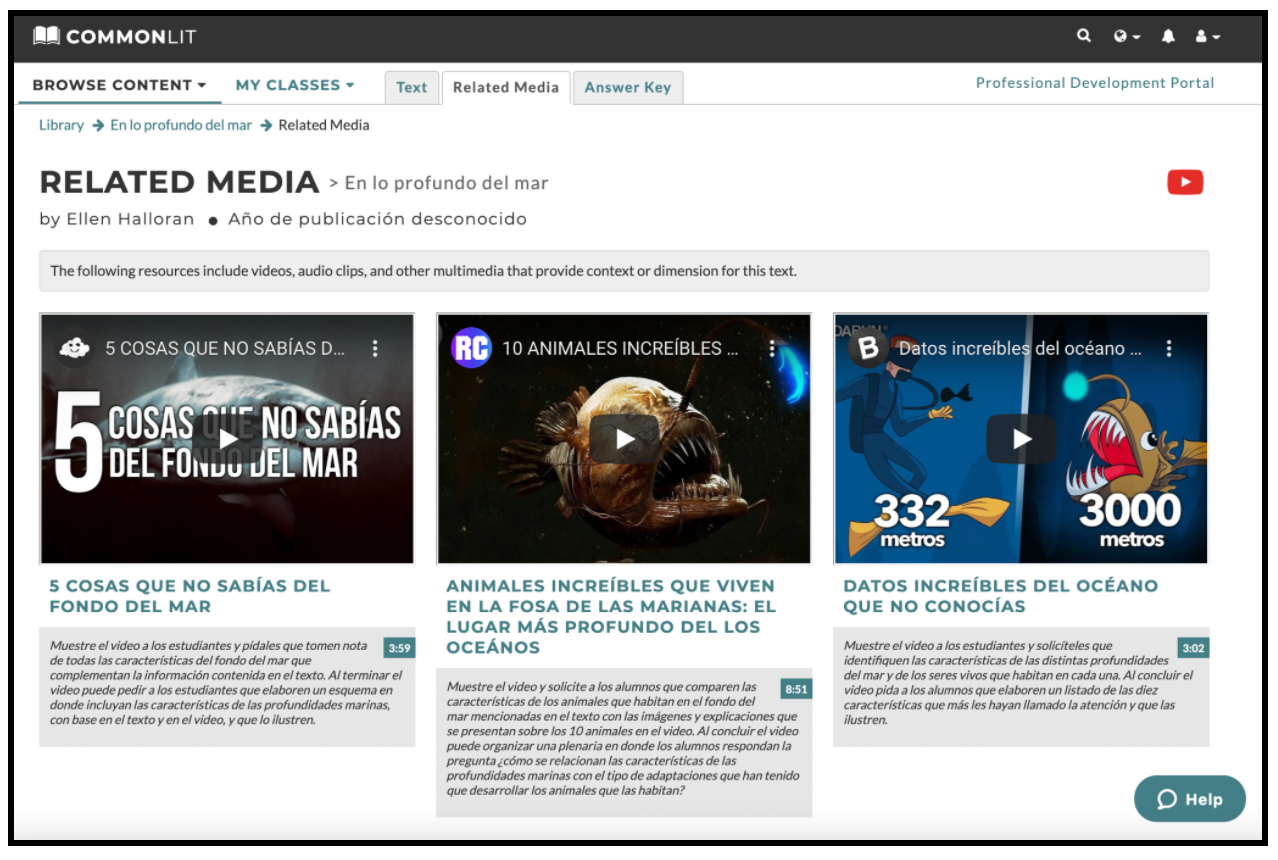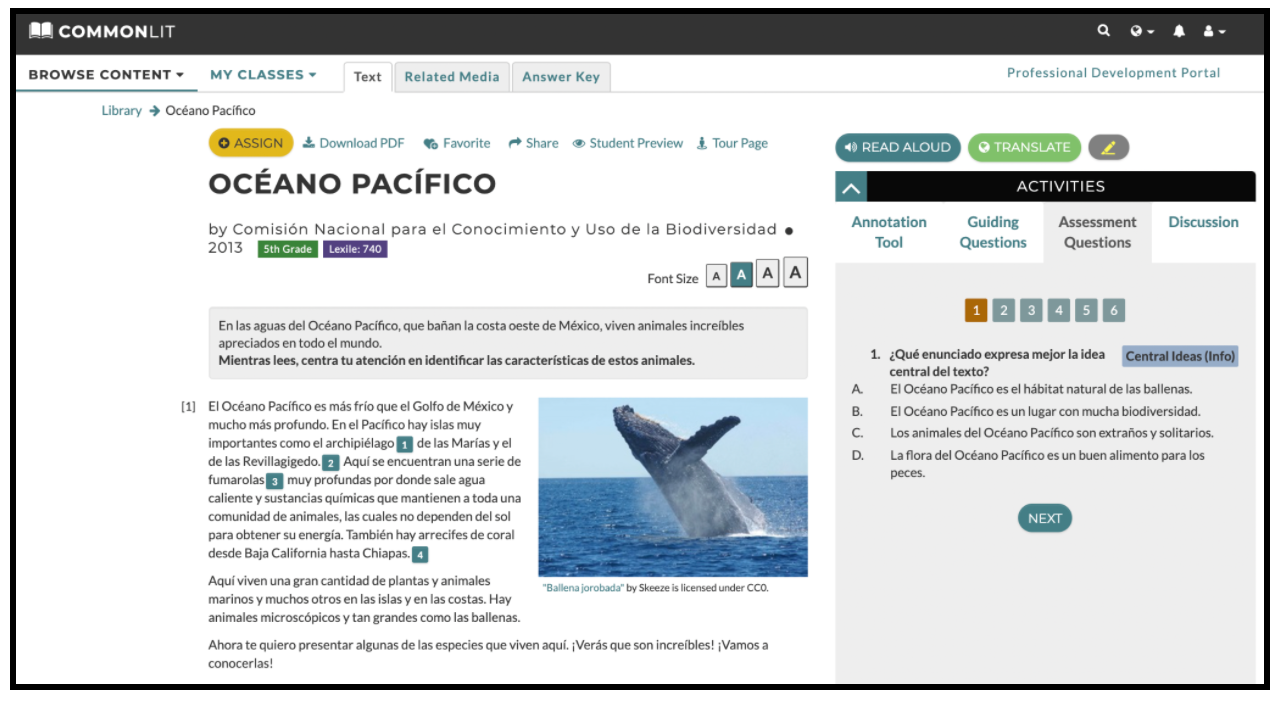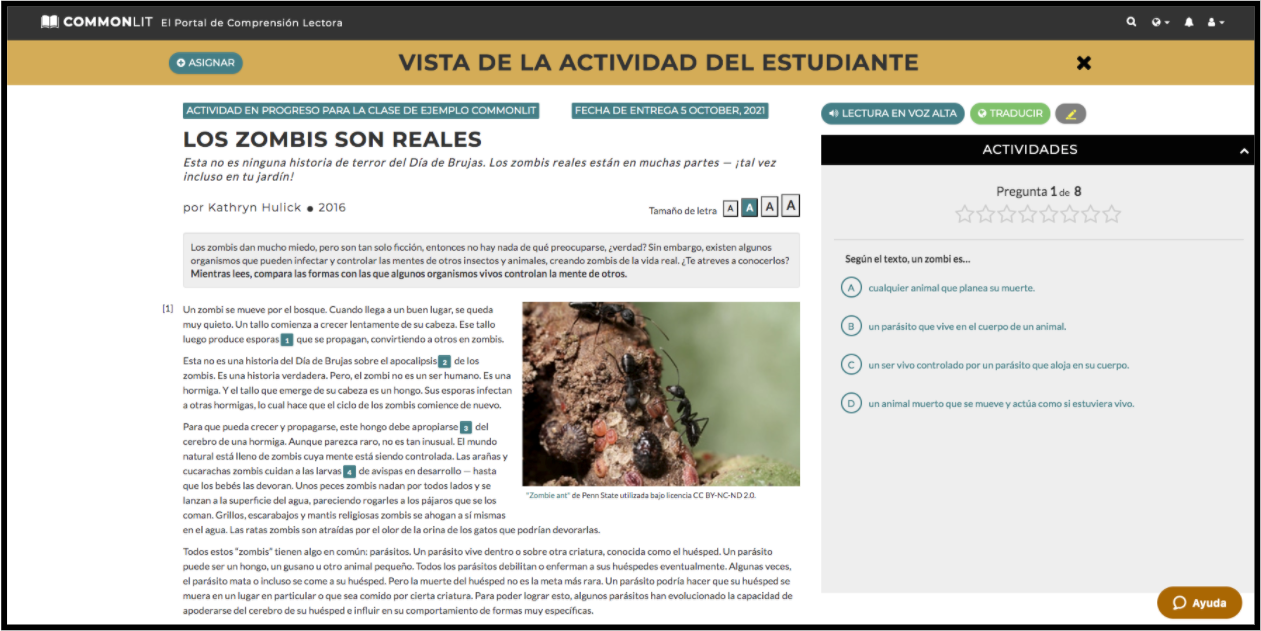 CommonLit Español
Spanish Texts about Animals for Elementary and Middle School Students
CommonLit Español
Spanish Texts about Animals for Elementary and Middle School Students
CommonLit offers many texts about interesting animals in Spanish to engage budding scientists and animal-lovers!
Leopards, penguins, salamanders, seahorses — what student doesn’t love learning about interesting animals? Studying the animal world with your students is a great way to engage them in reading nonfiction texts. Informational texts about different animals can hook young readers by teaching them new facts, broadening their background knowledge, and helping them make connections.
Here is a great set of informational texts about animals in Spanish from CommonLit for grades 3–8. These articles teach students about a wide variety of animals and their habitats around the world.
“Los leopardos” by Jonathan Sheikh-Miller y Stephanie Turnbull (3rd grade)
Students will learn all about leopards in this informational text. Leopards survive across a vast habitat, from parts of Africa to the south of Asia. Their varied diet and tree-climbing ability allow them to survive, but they face threats from human activity.
After reading, have students think about animal conservation by asking them Discussion Question 2, “¿Por qué el hogar de los leopardos está siendo destruido? ¿Cómo dañan las actividades humanas los lugares donde vive el leopardo?” In English, the question is, “Why are leopards’ homes being destroyed? How do human activities damage the places leopards live?” Encourage students to use evidence from the text to support their thinking.
“El Ártico: ¡Qué lugar tan frío!” by Nancy White (3rd grade)
This interesting text teaches students about the Arctic, a very cold climate in which many unique animals manage to thrive. Animals like polar bears and arctic foxes have adaptations including thick fur, layers of fat, and small ears to help them conserve heat and stay warm. Some animals also have fur that turns white when there is snow on the ground and changes to gray when the snow melts.
While students read, have them follow the annotation task. Students will take notes on the characteristics of the animals that live in the Arctic. After reading, have students use their notes to discuss how the animals’ unique characteristics help them survive in their very cold habitat.

“Los tigres” by Jonathan Sheikh-Miller y Stephanie Turnbull (4th grade)
Students will learn about tigers across Asia in this informational text. Tigers in Siberia, India, and Bangladesh are uniquely adapted to the climates in which they live. These different tigers also have features in common, including their enormous appetites and the threats they face from habitat destruction.
As students read, have them follow the annotation task, which asks them to take notes on how the tigers’ characteristics differ depending on their environment. After reading, students could share their notes to compare and contrast the different kinds of tigers in the article.
“En lo profundo del mar” by Ellen Halloran (4th grade)
This engaging text teaches students about the deepest, darkest, coldest parts of the ocean. The ocean floor is the largest habitat on earth but remains largely unexplored. Students will be fascinated by the adaptations the animals have developed to help them survive without sunlight.
After reading, watch the video “5 cosas que no sabías del fondo del mar” under the “Related Media” tab. Have students make connections between the animals they read about in the text and the information they learn from the video. Encourage students to use specific evidence from the text and the video to support their thinking.

“Océano pacífico” by Comisión para el Conocimiento y Uso de la Biodiversidad (5th grade)
In this informational text, students will learn about various plants and animals that live in the Pacific Ocean. Whales, jellyfish, starfish, turtles, and coral all have unique characteristics that allow them to thrive in their ecosystem.
As an extension after reading, students could pick one of the animals described in the text and conduct a mini research project. Students could study their chosen animal’s life cycle and adaptations, then create a presentation or make a poster to share their learning with the class.

“Intimida al enemigo” by Magda Pérez (7th grade)
In this text, students will learn all about western African meerkats, mammals that live in colonies with up to forty members. The author explains the various strategies meerkats use to survive. These include intimidating predators by standing tall, using sharp claws to dig holes and climb trees, and working as a group to find food and take care of their young.
After reading, have students think about how living together helps meerkats and other animals survive. Ask Discussion Question 2, “En el texto se describe el espíritu de cooperación de las suricatas, ¿que otros animales conoces que tengan esa misma característica?” In English, the question is, “The text describes the cooperative spirit of meerkats. What other animals do you know that have that same characteristic?”
“Las salamandras” by Rubén Coletta (7th grade)
In this informational text, the author explores how salamanders have a wide range of characteristics that are dependent on the environment in which they live. Salamanders can be tiny or big, seeing or blind, and many different colors. Students will be fascinated by the huge differences among salamanders around the world!
As students read, have them follow the annotation task, which asks them to take notes on the relationship between the salamanders’ characteristics and their environments. Encourage students to highlight specific evidence from the text that supports their thinking. After reading, students can share the connections they noticed with a partner or a small group.
“Un padre da a la luz” por Haydée Zayas (7th grade)
In this interesting text, the author explains seahorses’ many unique characteristics. Seahorses’ sizes, shapes, and colors are affected by the environment in which they live. The way seahorses eat and reproduce in particular will intrigue your students.
While students read, have them follow the annotation task. Students will take notes on the relationship between the seahorses’ marine ecosystem and their behavior. If students also read “Las salamandras,” described above, they could compare and contrast how seahorses and salamanders adapt to their environments.
“Los zombis son reales” by Kathryn Hulick (8th grade)
This creepy text teaches students about zombies — not the fictional ones in horror movies, but animals whose brains have been infected by parasites. Scientists study how different parasites and fungi infect the brains of ants, spiders, cockroaches, and killifish. These invaders control their hosts’ brains to make them engage in behavior helpful to the parasites.
Consider turning on Guided Reading Mode to ensure students understand what the scientists are studying. Guided Reading Mode chunks the text into smaller pieces with a comprehension question after each section. Students must answer each comprehension question correctly to reveal the next chunk of text. Guided Reading Mode is a great way to help students monitor their own comprehension as they read!

Next Steps
Looking for more Spanish texts on CommonLit? Browse the CommonLit Español library!
If you’re interested in learning all about CommonLit’s free Spanish digital literacy program, join one of our upcoming webinars!

